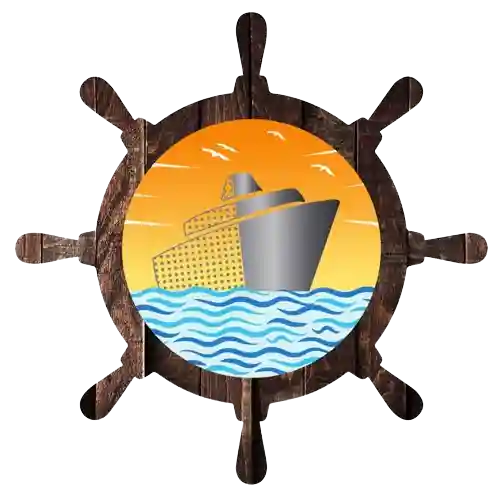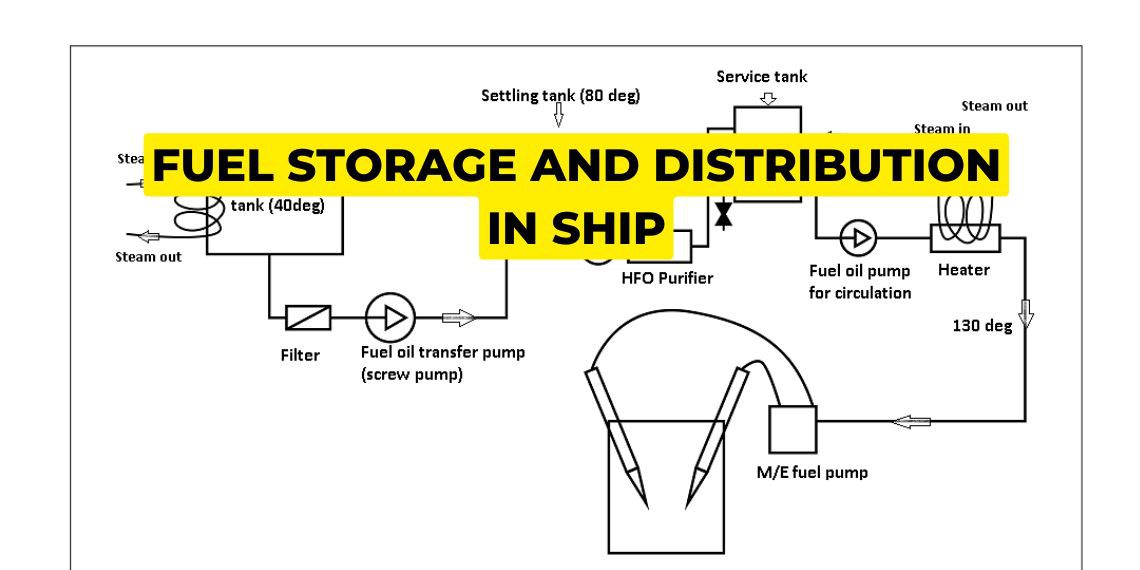Fuel storage and distribution in ship
Fuel storage and distribution play a crucial role in the smooth and efficient operation of ships, which are essential for global trade, transportation, and naval activities. Ships rely on a variety of fuels to power their engines, such as diesel, heavy fuel oil and liquefied natural gas (LNG).
Fuel storage systems in ships are designed to accommodate the considerable energy requirements during long voyages, ranging from short-haul trips to transoceanic journeys. The distribution of fuel on board ships involves a network of piping, valves, pumps, and other equipment necessary to transport fuel from storage tanks to the engines or other auxiliary machinery. The distribution system is designed to ensure a reliable supply of fuel to the engines while maintaining the safety of the crew and the vessel.
Lets see where fuel is stored and how it is distributed in ship:
Bunkering:
Bunkering refers to the process of supplying fuel to a ship, typically while it is at port or at anchor. Bunkering is an important operation for ships, as they require large quantities of fuel to power their engines and travel long distances.

Bunkering involves the transfer of fuel from a bunker barge or a fueling station to the ship’s fuel tanks. The barge connects its hose to the pipeline of the main manifold which is called Bunker manifold.

Storage tanks:
Fuel is transferred to the storage tanks from the Bunker Manifold, there can be two, three or four tanks and fuel is stored in those tanks. Steam coils are connected to the storage tanks through which steam comes in and goes out to maintain a temperature of 40 °C. We have to ensure that the temperature in the storage tanks is more than cloud point and pour point. Then fuel flows through the filter, gets cleaned.
Settling tanks:

Then the fuel is transferred to the settling tank by a screw pump, again in the settling tank there is steam coils connected and 80∘ C temperature is maintained. In the settling tank all the dirt particles, even water which is heavier than oil settles down below at the tank. Once all the dirt settles down a drain which is connected at the bottom of the tank through which all the dirt flows out.
Heavy fuel oil purifier:

Then a heavy fuel oil purifier pump transfers the oil to the heavy fuel oil purifier. This purifier works on the principle of centrifugal force in which it rotates at a 9000 rpm and when fuel passes through it, particles like water and dirt get separated from it because of the higher mass of the particles. Since water molecules are heavier and have a higher density so it goes out and fuel is separated, in this step a finer separation of oil, dirt and water takes place.
Service tanks:

Then oil moves to the service tank and over there it is further heated to 90°C, in service tank fuel is ready to give service to the engine. From the service tank fuel is transferred through a fuel oil circulating pump where pressure is increased to 7 bars and fuel goes through a heater where the temperature is increased from 90°C to 130°C so that we have viscosity of 13 cst when it reaches the main engine fuel pump.
Fuel from the main engine pump is sent to the fuel valves, fuel pump is connected with the camshaft and when the engine is running rotating the camshaft the fuel pump starts pumping the fuel at a very high pressure into the fuel valve. The fuel valve itself opens at 380 bars pressure, so the pump needs to develop a pressure more than 380 bars then only fuel gets to the combustion chamber in finely atomized form through the fuel nozzles. And this is how the whole process of fuel storage and distribution is competed.
What is the role of settling tank in fuel storage and distribution on a ship?
The primary role of a settling tank is to separate solid particles and other impurities from the oil before going to the heavy oil purifier. The tank works by allowing the mixture to settle, with the heavier solids to sink to the bottom and the lighter oil stays at top. The settled solids are then removed and disposed of by opening the valve which is attached at the bottom of the tank. Fuel is also heated in the tank to 80°C with the help of steam coils which pass through the tank.
What is the role of a service tank in fuel storage and distribution on a ship?
The role of a service tank is to store and supply treated oil to the main engine, auxiliary engine and boilers. Oil is heated in the service tank to 90°C with the help of steam coils which pass through the tank. Service tanks ensure that all the fuel oil is readily available for use when needed.
What is the role of a heavy oil purifier in fuel storage and distribution?
A heavy oil purifier, also known as a fuel oil purifier or a centrifugal separator, is a machine used on ships to purify heavy fuel oil before it is used in the ship’s engines.
The main key roles of a heavy oil purifier are:
1. Separation of water and oil:
Heavy oil purifiers are designed to separate water and solid particles from the fuel oil. This prevents the water from entering the engine, which can cause corrosion and damage, and removes the solid particles that can clog the engine’s fuel system.
2. Removal of impurities:
Heavy oil purifiers can remove impurities such as sediment, and other contaminants that can negatively affect the engine’s performance.
3. Improved fuel efficiency:
Purifying the fuel oil with a heavy oil purifier can improve the engine’s fuel efficiency by ensuring that the fuel is clean and free of contaminants.
4. Extended engine life:
Using a heavy oil purifier can help extend the life of the ship’s engines by reducing the wear and tear caused by contaminants in the fuel.
Note:
If you want to learn more about this topic, we suggest checking out our Combo package with the given link https://merchantnavydecoded.com/courses/c/ . It’s a great way to dive deeper into the subject through video explanations. This package covers all the important details and presents them in an easy-to-understand format. Watching the videos will help you grasp the topic better and make learning more enjoyable. So, we highly recommend giving our Combo package a try to enhance your knowledge on the subject.
Disclaimer :- The opinions expressed in this article belong solely to the author and may not necessarily reflect those of Merchant Navy Decoded. We cannot guarantee the accuracy of the information provided and disclaim any responsibility for it. Data and visuals used are sourced from publicly available information and may not be authenticated by any regulatory body. Reviews and comments appearing on our blogs represent the opinions of individuals and do not necessarily reflect the views of Merchant Navy Decoded. We are not responsible for any loss or damage resulting from reliance on these reviews or comments.
Reproduction, copying, sharing, or use of the article or images in any form is strictly prohibited without prior permission from both the author and Merchant Navy Decoded.





Thank you for sharing your knowledge.